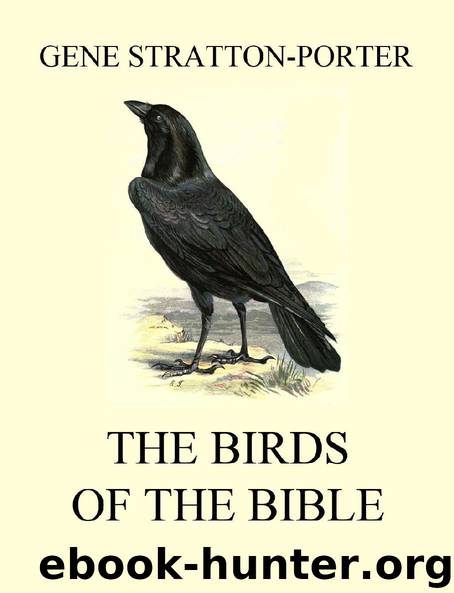The Birds of the Bible by Gene Stratton-Porter

Author:Gene Stratton-Porter [Stratton-Porter, Gene]
Language: eng
Format: epub
Tags: Klassiker
Publisher: Jazzybee Verlag
Published: 2017-02-05T00:00:00+00:00
CHAPTER VII – THE SPARROW
UNDOUBTEDLY no other of the small birds included in the Hebrew "tzippor" was so friendly near houses and in gardens as the sparrow. It seems from the text that this word is indiscriminately translated "sparrow" and "birds" or "fowl," as it appears almost forty times in Bible text and is, as a rule, translated "bird," but again distinctively "sparrow." The word covered all small birds nearest sparrows in characteristics and habits, all of which were allowed for food. When the sparrow was designated it was, no doubt, in places where it best filled the requirements of the text.
All of these little brown birds of friendly habit that we think of as like our sparrows swarmed over the plains of Gennesaret. They were of plainer, more even color than ours, the same size, and of slightly varying families. We have at least sixty-seven different sparrows. Of these the chipping and song sparrows are birds of the small shrubs and bushes, and the ground sparrow nests on the earth. I believe all of these birds originated in Arabia, also our English sparrow, that is imported. Sparrows are the domestic fowl of the wild, and since their history has been kept they have been noted for their love of man and their fearless disposition.
In the north of Palestine, the land of Gennesaret, and on the west of the Sea of Galilee, there lies hilly country, plains, and fertile fields, scattered over with villages.
Here, around the foot of Mt. Tabor and over the plains of Esdraelon, swarmed the sparrows, friendly little birds, seeking the protection of man. The bushes of every tiller of the soil, the vineyards of the wine-growers, and the orchards of fruit-raisers were filled with their lively chatter.
The only mention Pliny made of the sparrow was to point out the neat little hop with which it traveled on the ground or on buildings. It flew in short stretches from bush to bush, and built a small beautiful nest. If this was placed in bushes, there was an outside of tiny sticks and twigs, and the inner lining of hairs wound round and round. Ground nests dispensed with the outside work, and in a little tuft of weeds or grass, which formed an arching cover, the small, round bowl of hair was placed, and in it from four to six bluish, speckled eggs. The old ones with endless chatter hunted food for the young, bringing to them in a day hundreds of tiny insects and worms. The feces were carried from the nest, so that on leaving it was immaculately clean and showed no sign of ever having been used.
Because they nested so closely around houses and were so protected, they brought off their big broods in safety, and two or three in a year. Thus in congenial territory they soon increased to great numbers. They were very numerous west of Galilee almost to the coast. They nested in thorn, bramble, hazel, and juniper bushes, and among the grasses of earth.
Download
This site does not store any files on its server. We only index and link to content provided by other sites. Please contact the content providers to delete copyright contents if any and email us, we'll remove relevant links or contents immediately.
The Five People You Meet in Heaven by Mitch Albom(2868)
Name Book, The: Over 10,000 Names--Their Meanings, Origins, and Spiritual Significance by Astoria Dorothy(2513)
Real Sex by Lauren F. Winner(2505)
The Holy Spirit by Billy Graham(2451)
The Secret Power of Speaking God's Word by Joyce Meyer(2275)
How The Mind Works by Steven Pinker(2250)
0041152001443424520 .pdf by Unknown(2247)
ESV Study Bible by Crossway(2207)
Ancient Worlds by Michael Scott(2135)
The Meaning of the Library by unknow(2089)
The Gnostic Gospels by Pagels Elaine(2054)
Churchill by Paul Johnson(2032)
The ESV Study Bible by Crossway Bibles(2022)
MOSES THE EGYPTIAN by Jan Assmann(1992)
Jesus by Paul Johnson(1908)
Ancient Near Eastern Thought and the Old Testament by John H. Walton(1869)
The Complete Dead Sea Scrolls in English (7th Edition) (Penguin Classics) by Geza Vermes(1865)
The Nativity by Geza Vermes(1865)
City of Stairs by Robert Jackson Bennett(1860)
